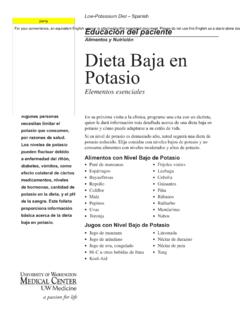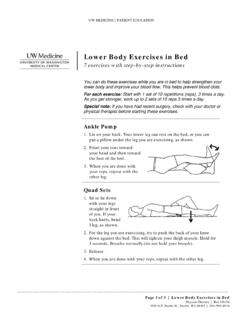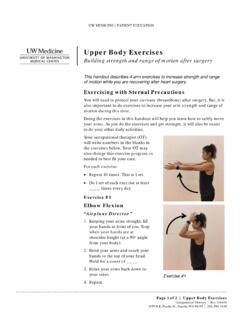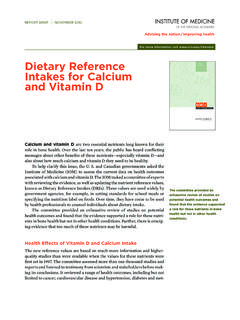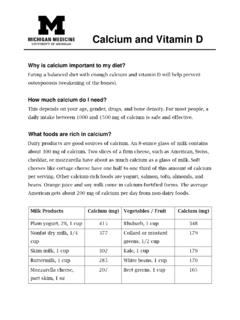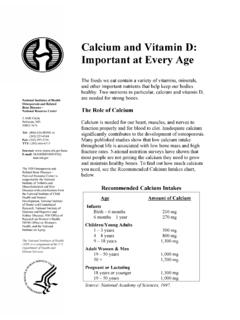Transcription of Calcium and Vitamin D - University of Washington
1 Calcium and Vitamin D What are Calcium and Vitamin D? Calcium and Vitamin D are nutrients you need to maintain bone strength and density. You need Calcium for blood clotting, muscle contraction, and normal nerve function. You need Vitamin D for Calcium absorption and transport to the bones. How much do I need? Calcium : A measurement of Calcium in the blood does not tell us if you are receiving enough of this nutrient in our diet. Therefore, we use the recommended intake levels listed in the table on the next page. Vitamin D: Vitamin D levels are measured with a lab test called 25-hydroxy Vitamin D. The SCCA normal reference range for 25-hydroxy Vitamin D is 30-50 mg/ml.
2 You might need more Calcium and Vitamin D if you: Are taking prednisone or a similar corticosteroid drug. Have osteopenia or osteoporosis. Are a child or teen. Are a post-menopausal woman. How do I read a food label for Calcium and Vitamin D content? Calcium : Multiply the percentage (%) Calcium by 10 to know the milligrams of Calcium per serving. For example, a food product with 20% Calcium has 200 mg per serving. Vitamin D: Vitamin D in supplements and food is measured in international units (IU). The percentage (%) Vitamin D on a food label is based on a recommended daily intake of 400 IU. For example, if the label states that the product contains 25% Daily Value of Vitamin D, this equals 100 IU Vitamin D.
3 2 Daily Calcium and Vitamin D Requirements Age and Gender: Calcium Vitamin D 1-3 years 4-8 years 9-18 years 19-50 years 50-70 years Over 70 years 700 mg 1000 mg 1300 mg 1000 mg men, 1200 mg women 1200 mg 1200 mg 600 IU 600 IU 600 IU 600 IU 600 IU 800 IU Post-menopausal women not receiving hormone replacement therapy 1500 mg 600-800 IU Children receiving steroid therapy: 1-5 years 6-8 years 9-18 years 1000 mg 1200 mg 1500 mg 600 IU 600 IU 800 IU Adults diagnosed with osteopenia, osteoporosis or receiving steroid therapy 1500 mg 1000 IU Choosing a Calcium and Vitamin D Supplement If you are unable to get enough Calcium or Vitamin D from food, consider a supplement. Vitamin D can either come in a Calcium supplement or be taken separately.
4 Discuss which is best for you with a dietitian. Tips to Remember When Taking a Supplement Take supplements 2-3 times a day for better absorption. We only absorb up to 500 mg at one time. Do not take a Calcium supplement within 2 hours of MMF or Myfortic . Calcium citrate products such as Citracal can be taken with or without food. Calcium carbonate products such as Caltrate , Calcium chews and Tums must be taken with food for best absorption and to prevent stomach and/or intestinal upset. Calcium Content of Selected Supplements Calcium Supplement Serving Size Calcium (mg) Vitamin D (IU) Caltrate 600 + D 1 600 400 Citracal + D 1 315 200 Calcium / Vitamin D chews 1 500 200 Tums : Not generally recommended since they do not contain Vitamin D.
5 O Regular Strength o E-X o Ultra o 500 Calcium Supplement 1 1 1 1 200 300 400 500 0 0 0 0 Most multivitamins contain 200 mg Calcium and 400 IU Vitamin D. You can get the rest of your of Calcium and Vitamin D with diet and/or supplements. See tables below for Calcium and Vitamin D content of foods. 3 Foods with High Calcium Content (actual amount varies with brand) Food Serving size mg Calcium Cheese products: Ricotta cheese cup 300 Swiss cheese 1 ounce 270 Cheddar cheese, mozzarella, Monterey jack 1 ounce 200 String cheese stick 1 ounce 150 Parmesan cheese 1 Tablespoon 70 Cottage cheese cup 35 Cream cheese 1 Tablespoon 12 Milk and soy products: Milk, Calcium fortified 1 cup 400 Milk (nonfat, 1%, 2%, whole, buttermilk) 1 cup 300 Soy milk, Calcium fortified 1 cup 300 Yogurt (soy or cow s milk) 6-8 ounces 200-500 Macaroni and Cheese 1 cup 100-300 Tofu cup 130 Soybeans (cooked) 1 cup 175 Ice cream cup 60 Other plant foods.
6 Blackstrap molasses 2 Tablespoons 400 Total cereal 1 cup 500 Juice, Calcium -fortified 1 cup 300 Energy bar 1 each 200-350 Brewer s yeast* 3 ounces 210 Watercress 3 ounces 150 Bok choy 1 cup 160 Greens (turnip, collard, beet, dandelion, mustard) 1 cup 150-180 Sunflower seeds 3 ounces 120 Sesame seeds 3 ounces 110 Broccoli 1 cup 100 Tahini 2 Tablespoons 130 Almond butter, Sesame butter 2 Tablespoons 85-100 Nuts (almonds, chestnuts, filberts, walnuts) cup 100-150 Beans and legumes: kidney, garbanzo, black-eyed baked or refried cup cup 65 50 4 Foods with High Vitamin D Content (actual amount varies with brand) Food Serving size IU Vitamin D Fish/seafood: Herring 3 ounces 1385 Halibut 3 ounces 510 Canned salmon 3 ounces 500 Mackerel 3 ounces 300 Canned tuna 3 ounces 200 Shrimp 3 ounces 150 Sardines 2 each 65 Milk and Soy products: Milk (nonfat, 1%, 2%, whole, buttermilk) 1 cup 100 Soy milk, Calcium / Vitamin D fortified 1 cup 100 Tofu cup 130 Other foods: Juice, Calcium / Vitamin D fortified 1 cup 100 Sunflower seeds 3 ounces 90 *Not all foods on this list are allowed on the Immunosuppressed Patient Diet.
7 If you have questions about foods on this list, please contact your SCCA dietitian or call 206-606-1148 to be directed to a dietitian. This education resource was intended to be given as a part of a nutrition consult by an SCCA dietitian. Questions? Ask an SCCA dietitian at References/for more information: National Institutes of Health, Office of Dietary Supplements: Calcium : Vitamin D: The Vegetarian Resource Group #table1 Notes: 2011 Seattle Cancer Care Alliance, revised 2017




